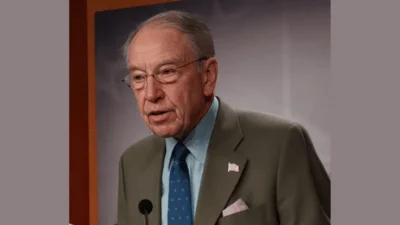The Congressional Record is a unique source of public documentation. It started in 1873, documenting nearly all the major and minor policies being discussed and debated.
“STATEMENTS ON INTRODUCED BILLS AND JOINT RESOLUTIONS” mentioning the U.S. Dept of Agriculture was published in the Senate section on pages S3539-S3542 on May 11, 2010.
The publication is reproduced in full below:
STATEMENTS ON INTRODUCED BILLS AND JOINT RESOLUTIONS
By Mrs. FEINSTEIN (for herself and Mr. Brown of Ohio):
S. 3336. A bill to amend the internal Revenue Code of 1986 to provide for the treatment of bonds issued to finance renewable energy resources facilities, conservation and efficiency facilities, and other specified greenhouse gas emission technologies; to the Committee on Finance.
Mrs. FEINSTEIN. Mr. President, I rise to introduce the Private Activity Renewable Energy Bonds Act, legislation to enable low-cost Private Activity Bond financing for businesses and local governments which seek to create renewable, clean and efficient sources of energy.
The bill is cosponsored by Senator Brown of Ohio. In the United States House of Representatives, Congressman Mike Thompson has introduced a bipartisan companion bill cosponsored by Representatives Dean Heller and Mary Bono Mack.
The bill is supported by a host of business and government leaders and renewable energy companies including the Solar Energy Industries Association, Solar Millennium, Nano Solar, the National Association of Energy Service Companies, EnLink GeoEnergy, Johnson Controls, A123 Systems, the Center for Energy Efficiency and Renewable Technologies, and the U.S. Fuel Cell Council, as well as California Treasurer Bill Lockyer.
The bill provides businesses access to low interest tax free Private Activity Bonds, in order to fund projects that generate renewable energy; produce energy or water savings, or; develop highly efficient vehicles.
To promote such activity in a fiscally responsible manner, the legislation caps the value of bonds at $2.5 billion annually. This represents the investment necessary to replace at least one percent of U.S. electricity generation with renewable sources over the next ten years.
Private Activity Bonds have long been used to generate private involvement and investment in critically important infrastructure for our Nation--from wharves to airports, intercity rail to solid waste disposal facilities and hospitals.
In this century, however, we have new national goals.
Renewable, clean and efficient energy projects will produce jobs, get our economy back-on-track and sustain us as the global leader of a greener century.
These projects, however, require significant front-end capital investment to which the federal government cannot be the sole provider. Private Activity Bonds can prove a critical tool in garnering private investment, because their interest rates typically run a few percent points under commercially available loans.
Investors have long responded to this type of incentive. According to the IRS, Private Activity Bond issuance in 2007 was over $130 billion--
supplying capital to our markets, providing the financing to get projects off the ground.
Projects financed in part by Private Activity Bonds include additions to the San Jose and San Francisco International Airports, the Capitol Beltway High Occupancy Vehicle lanes, infrastructure improvements to the Port of Seattle, and upgrades to Children's Hospital of Orange County, Catholic Healthcare West in San Francisco, and many, many important facilities and projects.
With proper access to capital, we've already seen partnerships between States, municipalities and businesses develop into successful renewable energy programs.
In California, Energy Financing Districts finance residents who choose to install clean energy projects such as distributed solar panels on their homes.
The cost of the solar panel installation or other device is paid back through an increase in property tax only for those property owners who choose to participate in the program.
Now, going solar or installing a geothermal heat pump, which once cost tens of thousands of dollars upfront, has little or no upfront cost to the property owner. It is no wonder why 150 of these programs have been established throughout the country.
This low cost solar opportunity is just one example of the type of programs this bill seeks to support. In partnership, businesses and local governments will develop new and innovative was to create the new high quality jobs of the 21st century.
This Congress and this President have outlined goals to ensure this country leads the world in the creation of a robust, green economy.
This bill looks to connect that laudable goal with proven financing tools to get us there by aligning private sector investment power and job growth with good public policy.
Mr. President, I ask unanimous consent that the text of the bill be printed in the Record.
There being no objection, the text of the bill was ordered to be printed in the Record, as follows:
S. 3336
Be it enacted by the Senate and House of Representatives of the United States of America in Congress assembled,
SECTION 1. SHORT TITLE.
This Act may be cited as the ``Private Activity Renewable Energy Bonds Act''.
SEC. 2. TREATMENT OF BONDS ISSUED TO FINANCE RENEWABLE ENERGY
RESOURCE FACILITIES AND CONSERVATION AND
EFFICIENCY FACILITIES AND OTHER SPECIFIED
GREENHOUSE GAS EMISSION TECHNOLOGIES.
(a) In General.--Section 142(a) of the Internal Revenue Code of 1986 is amended by striking ``or'' at the end of paragraph (14), by striking the period at the end of paragraph (15) and inserting a comma, and by inserting after paragraph (15) the following new paragraphs:
``(16) renewable energy resource facilities,
``(17) conservation and efficiency facilities and projects, or
``(18) high efficiency vehicles and related facilities or projects.''.
(b) Renewable Energy Resource Facility.--Section 142 of the Internal Revenue Code of 1986 is amended by adding at the end the following new subsection:
``(n) Renewable Energy Resource Facilities.--For purposes of subsection (a)(16)--
``(1) In general.--The term `renewable energy resource facility' means--
``(A) any facility used to produce electric or thermal energy (including a distributed generation facility) from--
``(i) solar, wind, or geothermal energy,
``(ii) marine and hydrokinetic renewable energy,
``(iii) incremental hydropower,
``(iv) biogas and solids produced in the wastewater treatment process, or
``(v) biomass (as defined in section 203(b)(1) of the Energy Policy Act of 2005 (42 U.S.C. 15852(b)(1))),
``(B) any facility used to produce biogas, or
``(C) any facility or project used for the manufacture of facilities referred to in subparagraph (A) or (B).
``(2) Special requirements for facilities producing biogas.--
``(A) In general.--A facility shall not be treated as described in paragraph (1)(B), unless the biogas produced--
``(i) is of pipeline quality and distributed into a vehicle for transportation or into an intrastate, interstate, or LDC pipeline system, or
``(ii) is used to produce onsite electricity or hydrogen fuel for use in vehicular or stationary fuel cell applications and has a British thermal unit content of at least 500 per cubic foot.
``(B) Pipeline quality.--For purposes of subparagraph
(A)(i), with respect to biogas, the term `pipeline quality' means biogas with a British thermal unit content of at least 930 per cubic foot.
``(3) Definitions.--For purposes of this subsection--
``(A) Geothermal energy.--The term `geothermal energy' means energy derived from a geothermal deposit (within the meaning of section 613(e)(2)) or from geothermal heat pumps.
``(B) Marine and hydrokinetic renewable energy.--The term
`marine and hydrokinetic renewable energy' has the meaning given such term in section 45(c)(10).
``(C) Incremental hydropower.--The term `incremental hydropower' means additional energy generated as a result of efficiency improvements or capacity additions to existing hydropower facilities made on or after the date of enactment of this subsection. The term `incremental hydropower' does not include additional energy generated as a result of operational changes not directly associated with efficiency improvements or capacity additions.
``(D) Biogas.--The term `biogas' means a gaseous fuel derived from landfill, municipal solid waste, food waste, wastewater or biosolids, or biomass (as defined in section 203(b)(1) of the Energy Policy Act of 2005 (42 U.S.C. 15852(b))).
``(4) Special rules for energy loan tax assessment financing.--
``(A) In general.--In the case of any renewable recovery energy resource facility provided from the proceeds of a bond secured by any tax assessment loan upon real property, the term `facility' in paragraph (1) includes--
``(i) a prepayment for the principal purpose of purchasing electricity from renewable energy resource property, and
``(ii) a prepayment of a lease or license of such property, but only if the prepayment agreement provides that it shall not be canceled prior to the expiration of the tax assessment loan.
``(B) Tax assessment loan.--For purposes of subparagraph
(A), the term `tax assessment loan' shall mean a governmental assessment, special tax, or similar charge upon real property.''.
(c) Conservation and Efficiency Facility or Project.--Section 142 of the Internal Revenue Code of 1986, as amended by subsection (b), is amended by adding at the end the following new subsection:
``(o) Conservation and Efficiency Facilities and Projects.--
``(1) In general.--For purposes of subsection (a)(17), the term `conservation and efficiency facility or project' means--
``(A) any facility used for the conservation or the efficient use of energy, including energy efficient retrofitting of existing buildings, or for the efficient storage, transmission, or distribution of energy, including any facility or project designed to implement smart grid technologies (as described in title XIII of the Energy Independence and Security Act of 2007, or individual components of such technologies as listed in section 1301 of such Act),
``(B) any facility used for the conservation of or the efficient use of water, including--
``(i) any facility or project designed to--
``(I) reduce the demand for water,
``(II) improve efficiency in use and reduce losses and waste of water, including water reuse, and
``(III) improve land management practices to conserve water, or
``(ii) any individual component of a facility or project referred to in clause (i), or
``(C) any facility or project used for the manufacture of facilities referred to in subparagraphs (A) and (B).For purposes of subparagraph (B)(i), facility or project does not include any facility or project that stores water.
``(2) Special rules for energy loan tax assessment financing.--
``(A) In general.--In the case of any conservation and efficiency facility or project provided from the proceeds of a bond secured by any tax assessment loan upon real property, the term `facility' in paragraph (1)(A) includes--
``(i) a prepayment for the principal purpose of purchasing electricity from conservation and efficiency property, and
``(ii) a prepayment of a lease or license of such property, but only if the prepayment agreement provides that it shall not be canceled prior to the expiration of the tax assessment loan.
``(B) Tax assessment loan.--For purposes of subparagraph
(A), the term `tax assessment loan' shall mean a governmental assessment, special tax or similar charge upon real property.''.
(d) High Efficiency Vehicles and Related Facilities or Projects.--Section 142 of the Internal Revenue Code of 1986, as amended by subsections (b) and (c), is amended by adding at the end the following new subsection:
``(p) High Efficiency Vehicles and Related Facilities or Projects.--For purposes of subsection (a)(18)--
``(1) High efficiency vehicles.--The term `high efficiency vehicle' means any vehicle that will exceed by at least 150 percent the average combined fuel economy for vehicles with substantially similar attributes in the model year in which the production of such vehicle is expected to begin at the facility.
``(2) Facilities related to high efficiency vehicles.--A facility or project is related to a high efficiency vehicle if the facility is any real or personal property to be used in the design, technology transfer, manufacture, production, assembly, distribution, recharging or refueling, or service of high efficiency vehicles.''.
(e) National Limitation on Amount of Renewable Energy Bonds.--Section 142 of the Internal Revenue Code of 1986, as amended by subsections (b), (c), and (d), is amended by adding at the end the following new subsection:
``(q) National Limitation on Amount of Renewable Energy Bonds.--
``(1) In general.--An issue shall not be treated as an issue described in paragraph (16), (17), or (18) of subsection (a) if the aggregate face amount of bonds issued by the State pursuant thereto (when added to the aggregate face amount of bonds previously so issued during the calendar year) exceeds the amount allocated to the State by the Secretary under paragraph (2) for such calendar year.
``(2) Allocation rules.--
``(A) Allocation among states by population.--The Secretary shall allocate authority to issue bonds described in paragraph (16), (17), or (18) of subsection (a) to each State by population for each calendar year in an aggregate amount to all States not to exceed $2,500,000,000.
``(B) State allocation.--The State may allocate the amount allocated to the State under subparagraph (A) for any calendar year among facilities or projects described in paragraphs (16), (17), and (18) of subsection (a) in such manner as the State determines appropriate.
``(C) Unused renewable energy bond carryover to be allocated among qualified states.--
``(i) In general.--Any unused bond allocation for any State for any calendar year under subparagraph (A) shall carryover to the succeeding calendar year and be assigned to the Secretary for allocation among qualified States for the succeeding calendar year.
``(ii) Unused bond allocation carryover.--For purposes of this subparagraph, unused bond allocations are bond allocations described in subparagraph (A) of any State which remain unused by November 1 of any calendar year.
``(iii) Formula for allocation of unused bond allocation carryovers among qualified states.--The amount allocated under this subparagraph to a qualified State for any calendar year shall bear the same ratio to all States from the preceding calendar year under subparagraph (A), excluding States which are not a qualified State.
``(iv) Timing of allocation.--The Secretary shall allocate the unused bond allocation carried over from the preceding year among qualified States not later than March 1 of the succeeding year.
``(v) Qualified state.--For purposes of this subparagraph, the term `qualified State' means, with respect to a calendar year, any State--
``(I) which allocated its entire bond allocation under subparagraph (A) for the preceding calendar year, and
``(II) for which a request is made (not later than August 1 of the calendar year) to receive an allocation under clause
(iii).
``(vi) Reporting.--States shall report annually to the Secretary on their use of bonds described in paragraph (16),
(17), and (18) of subsection (a), including description of projects, amount spent per project, total amount of unused bonds, and expected greenhouse gas or water savings per project with a description of how such savings were calculated. Such reporting shall be submitted not later than November 1 of any calendar year.''.
(f) Coordination With Section 45.--Paragraph (3) of section 45(b) of the Internal Revenue Code of 1986 is amended by adding at the end the following new sentence: ``Clause (ii) of subparagraph (A) shall not apply with respect to any facility described in paragraph (16), (17), or (18) of section 142(a).''.
(g) Coordination With Section 45K.--Subparagraph (A) of section 45K(b)(3) of the Internal Revenue Code of 1986 is amended by adding at the end the following flush sentence:
``Subclause (II) of clause (i) shall not apply with respect to any facility described in paragraph (16), (17), or (18) of section 142(a).''.
(h) Coordination With Section 48.--Subparagraph (A) of section 48(a)(4) of the Internal Revenue Code of 1986 is amended by adding at the end the following flush sentence:
``Clause (ii) shall not apply with respect to any facility described in paragraph (16), (17), or (18) of section 142(a).''.
(i) Coordination With Section 146(g)(3).--Section 146(g)(3) of the Internal Revenue Code of 1986 is amended by striking
``or (15)'' and inserting ``(15), (16), (17), or (18)''.
(j) Effective Date.--The amendments made by this section shall apply to obligations issued after the date of the enactment of this Act.
______
Mr. UDALL of New Mexico:
S. 3340. A bill to create jobs, increase energy efficiency, and promote technology transfer, and for other purposes; to the Committee on Commerce, Science, and Transportation.
Mr. UDALL of New Mexico. Mr. President, I rise today to introduce the NIST GREEN JOBS Act, to provide NIST Grants for green jobs, improved energy efficiency, and small business growth.
It has never been easy to be an entrepreneur or small business owner, and this is especially true since the recession began 2 years ago. Many small firms in the manufacturing sector, in particular, have struggled during a time of tight credit markets and reduced consumer demand. In the last 2 years, the manufacturing sector lost over 2 million jobs.
Twenty years ago, when Americans worried about how our small companies would compete globally in the face of stiff competition from Asia, Congress established the Hollings Manufacturing Extension Partnership, MEP, Program to assist small manufacturers.
The MEP program has since helped thousands of small- and medium-sized manufacturers across the nation increase their profit-lines and streamline their business processes through lean manufacturing techniques. The National Institute of Standards and Technology, NIST, is the Federal steward for the nationwide MEP network, which has MEP Centers in all 50 States.
The New Mexico Manufacturing Extension Partnership in Albuquerque was one of the first such centers, and it provides small- and medium-sized manufacturers with the tools they need to grow, improve productivity and expand capacity. Since its creation, the New Mexico MEP has helped create or maintain more than 2,600 jobs in the State and achieve $24 million in annual cost savings for partner companies.
Today, as the U.S. continues to emerge from the worst recession since the Great Depression, the resources and expertise MEP provides manufacturers are more valuable than ever. Our MEP Centers do great work--and I believe they can do even more as companies look for ways to take advantage of new opportunities in a clean energy economy that promotes energy efficiency and independence for our country.
Since manufacturing now plays an increasingly important role in the construction industry, there is an important opportunity for the MEP program to strengthen its support of small manufacturers while also promoting green jobs and energy independence.
Builders today already rely on manufactured components and sub-
assemblies. Manufacturing will become even more important to construction as homes are increasingly ``assembled'' on site from components made in a factory. Now that lean, high-quality manufacturing is applicable to construction, it is not a stretch for MEP Centers to teach the same skills to the construction industry, where small firms are the norm.
Technologies exist today for green building construction and retrofitting that can reduce energy use and greenhouse gas emissions. Yet many small firms, especially in the construction sector, do not have the skills or expertise to take advantage of new technologies to improve the energy efficiency. Moreover, NIST researchers at the Buildings and Fire Research Lab already help develop standards and technologies to improve buildings. Buildings today consume 73 percent of electricity and 40 percent of overall energy.
These companies would benefit from the type of training and business analysis activities that MEP Centers already provide to manufacturers. The MEP system could thus be a powerful and transformational force to create green jobs, increase energy efficiency, and promote technological transfer in the construction industry.
That is why I ask for the support of my Senate colleagues for the NIST GREEN JOBS Act, to fund MEP Center pilot projects for green jobs related to energy efficiency. This proposal builds on provisions already authorized by America COMPETES legislation.
My bill simply broadens this existing competitive grant program for MEP pilot projects to include activities related to energy efficiency. It also allows MEP Centers to extend services to companies in the construction industry working in these areas. Awarded on a competitive basis, these pilot projects could last up to 3 years and would be located in each region of the country. The pilot projects would thus create models for new MEP activities and services that could be replicated at MEP Centers regionally or nationwide.
The NIST GREEN JOBS Act authorizes $7 million in annual funding for 3 years. This funding would allow at least one MEP Center in each region to conduct a pilot project. The MEP Centers would not need to provide local matching funds for these competitively awarded pilot projects.
I believe this modest proposal would be a positive step toward both helping create and retain jobs in the manufacturing sector and improving our Nation's energy independence.
I therefore urge the support of all my colleagues for this legislation.
______
By Mr. DURBIN:
S. 3342. A bill to amend the Richard B. Russell National School Lunch Act to establish a demonstration project to promote collaborations to improve school nutrition; to the Committee on Agriculture, Nutrition, and Forestry.
Mr. DURBIN. Mr. President, childhood obesity is a growing concern in the U.S. and I am pleased that the President and First Lady have decided to tackle this issue with the goal of solving the problem in a generation. Today, one in three children is overweight or obese, which means that they are at a greater risk of developing diabetes, heart disease and cancer over the course of their lives. We are spending nearly $150 billion a year to treat obesity-related medical conditions, and this problem will only become worse if we don't do something about it now.
One way that the Federal Government can play an important role in addressing this problem is by helping to make schools healthier. Students spend an average of nearly 7 hours a day at school, and it is one of the places where kids formally learn and then can practice healthy habits related to nutrition and physical activity. While education is primarily funded by the states, the Federal government plays a significant role in this issue as well because of its funding of the National School Lunch Program. This year, the U.S. Department of Agriculture, USDA, will spend $10.2 billion on the school lunch program, which serves 31 million children across the country every day. In my home State of Illinois, 1.1 million students in over 4,000 schools participate.
The National School Lunch Program was started after World War II, because our leaders then understood the importance of investing in good nutrition to ensure that the country's youth were well nourished and healthy. When President Harry Truman signed the National School Lunch Act, he said that ``in the long view, no nation is healthier than its children.''
Today, we know that the program is making a real difference in millions of kids' lives, by ensuring they don't go hungry during the school day and are ready to learn. We also know that there are some clear nutritional benefits of the program. USDA reports that research on the school lunches consistently shows that participants consume more milk and vegetables at lunch; have higher vitamin intakes; and consume fewer sweets, sweetened beverages, and snack foods than nonparticipants.
However, much of the difference in vegetable consumption may be due to a higher consumption of French fries and other potato products, and many lunches contain a higher percentage of calories from fat than currently recommended. USDA's current nutrition standards for school meals have not been updated since 1995 and are not in line with the most recent Dietary Guidelines for Americans. I think we need to take President Truman's words to heart, and make long-term investments in this program to ensure that kids are eating healthy meals.
I support the President's goal of increased funding, so that schools can afford to purchase healthier ingredients to make school lunches. However I know that the nutritional quality of school meals varies greatly across the country, and providing every school with adequate funding to improve their meals will be challenging. Some schools have already shown that even with limited resources they can make real improvements in the nutritional quality of their school meals, and make other changes to make school environments healthier.
I would like to build on that concept, which is why I am pleased today to introduce the Healthy School Partnerships Act of 2010. This bill will create a competitive grant program at USDA to allow public schools to explore innovative, sustainable programs that improve the nutritional profile of school meals and make other improvements to make school environments healthier. The bill authorizes $2 million per year for 5 years to fund collaborations of academic experts, dieticians and nutrition professionals, community partners, and local schools to implement and evaluate innovative models to improve food quality, student choices in food, and healthy school environments. This could include starting programs to improve the nutritional content of school meals; providing more nutrition education; changing school policies to promote greater access to healthier foods and physical activity; training teachers, school administrators and nurses; or making other changes to make school environments healthier. We need grass roots involvement and real-world models to solve the childhood obesity problem going forward, and this bill provides the funding to develop those.
Childhood obesity is a complex problem, and to effectively tackle it we will need the commitment of the public and private sectors. The Healthy Schools Partnerships Act of is one part of the solution. By tapping local resources and expertise, we can promote collaborations and develop sustainable and replicable models for making systemic changes that promote good nutrition and healthy living among students.
Mr. President, I ask unanimous consent that the text of the bill be printed in the Record.
There being no objection, the text of the bill was ordered to be printed in the Record, as follows:
S. 3342
Be it enacted by the Senate and House of Representatives of the United States of America in Congress assembled,
SECTION 1. SHORT TITLE.
This Act may be cited as the ``Healthy Schools Partnerships Act of 2010''.
SEC. 2. HEALTHY SCHOOLS PARTNERSHIPS DEMONSTRATION PROGRAM.
Section 18 of the Richard B. Russell National School Lunch Act (42 U.S.C. 1769) is amended by adding at the end the following:
``(j) Healthy Schools Partnerships Demonstration Program.--
``(1) Definition of eligible entity.--In this section, the term `eligible entity' means a school food authority that demonstrates that the school food authority has collaborated, or will collaborate, with 1 or more local partner organizations (including academic experts, registered dietitians or other nutrition professionals, community partners, or non-profit organizations) to achieve the purposes described in paragraph (2).
``(2) Purposes.--The purposes of the demonstration project established under this subsection are--
``(A) to assist schools in improving the nutritional standards of school meals and the overall school environment; and
``(B) to use local resources and expertise to promote collaborations and develop sustainable and replicable models for making systemic changes that promote good nutrition and healthy living among students.
``(3) Establishment.--The Secretary shall establish a demonstration project under which the Secretary shall make grants to eligible entities to fund collaborations of academic experts, nonprofit organizations, registered dietitians or other nutrition professionals, community partners, and local schools to test and evaluate innovative models to improve nutrition education, student decision making, and healthy school environments.
``(4) Application.--
``(A) In general.--An eligible entity shall submit to the Secretary an application at such time, in such manner, and containing such information as the Secretary may require.
``(B) Contents.--In addition to any other requirements of the Secretary, each application shall--
``(i) identify the 1 or more problems that the eligible entity will address;
``(ii) identify the activity that the grant will be used to fund;
``(iii) describe the means by which the activity will improve the health and nutrition of the school environment;
``(iv) list the partner organizations that will participate in the activity funded by the grant; and
``(v) describe the metrics used to measure success in achieving the stated goals.
``(5) Priority.--In making grants under this subsection, the Secretary shall give priority to eligible entities that demonstrate--
``(A) a severe need to improve the school environment, as demonstrated by high numbers of students receiving free or reduced price lunches, high levels of obesity or other indicators of poor health status, and health disparities in the community served by the school;
``(B) a commitment by community partners to make in-kind or cash contributions; and
``(C) the ability to measure results.
``(6) Use of funds.--An eligible entity shall use a grant received under this subsection--
``(A) to assess the problem of childhood obesity and poor nutrition in the school environment;
``(B) to develop an innovative plan or intervention to address specific causes of the problem in coordination with outside partners, including by developing and testing innovative models to improve student health and nutrition as measured by--
``(i) changes that result in healthier school environments, including more nutritious food being served in cafeterias and available a la carte;
``(ii) increased nutrition education;
``(iii) improved ability of students to identify healthier choices;
``(iv) changes in attitudes of students towards healthier food;
``(v) student involvement in making school environments healthier;
``(vi) increased access to physical activity, physical education, and recess;
``(vii) professional development and continuing education opportunities for school administrators, teachers, and school nurses; and
``(viii) changes in school policies that promote access to healthier food and physical activity;
``(C) to implement the plan or intervention in partnership with outside partners;
``(D) to measure and evaluate effectiveness of the intervention; or
``(E) to assess the sustainability and replicability of this model.
``(7) Authorization of appropriations.--There is authorized to be appropriated to carry out this subsection $2,000,000 for each of fiscal years 2011 through 2015.''.
____________________








